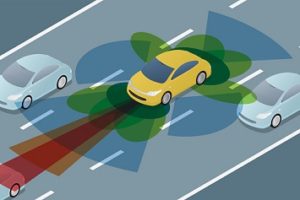Pretty soon, your car may be able to tell you what’s around the next corner, whether there’s stopped traffic in the fog bank ahead, and how to avoid construction traffic on your way to work each morning by communicating with other vehicles. Unfortunately, the same technology that will allow your car to exchange information with other vehicles has one glaring weakness: Like any other computer-controlled wireless communication system, it can be hacked.
Yesterday we looked at how vehicle-to-vehicle (V2V) communication will work, and its advantages over currently available technologies. Today we’ll look at specific ways that V2V communication can help to prevent crashes—and at the security vulnerability that is this technology’s Achilles’ heel.
Crash Avoidance Applications
Knowing where other vehicles are, how fast they’re moving (or not moving), and what direction they’re traveling can help your car keep you safe. The array of crash avoidance applications offered by V2V communications include:
- Intersection Movement Assist (IMA). This application prevents collisions by enabling vehicles to communicate and provide warnings to drivers at intersections.
- Left Turn Assist (LTA). Left turns create a risk of collision with oncoming traffic; LTA warns drivers of oncoming vehicles, including vehicles that are not visible to the driver because of obstructions.
- Emergency Electronic Brake Light (EEBL). This application provides advance warning when another V2V-equipped vehicle traveling in the same direction but not in the driver’s line of sight decelerates quickly. Other vehicles or poor weather conditions that affect visibility would not affect V2V communications, so drivers will not be surprised when traffic comes to a sudden stop.
- Forward Collision Warning (FCW). When there is another vehicle ahead in traffic, in the same lane, the FCW provides advance warning of the impending rear-end collision.
- Blind Spot Warning (BSW) and Lane Change Warning (LCW). BSW will notify the driver of vehicles in adjacent lanes that are in the vehicle’s “blind spot.” If the driver attempts a lane change while another vehicle is in the blind spot, the LCW provides notice of the hazard.
- Do-Not-Pass Warning (DNPW) provides a warning for the driver when it is not safe to pass a slower-moving vehicle because vehicles are approaching from the opposite direction.
Cybersecurity Concerns
Vehicles are already hackable, through their onboard computers. Hackers have demonstrated the ability to remotely disable the braking systems and engines of vehicles from thousands of miles away. So, wouldn’t putting V2V systems on all cars just increase their vulnerability?
It would—and not just to the type of hacking that can cause a highway crash. Drivers’ privacy could be at risk, as could personal information stored on their smartphones, while their phones are linked by Bluetooth connections to the car’s own systems. The National Highway Traffic Safety Administration (NHTSA) has already ordered the recall of more than 1.4 million vehicles for the purpose of upgrading their security. So how would the NHTSA safeguard cars that are always connected?
The NHTSA proposes to use a modified and upgraded public key infrastructure (PKI) system to protect V2V systems. PKI is already widely used in banking and credit card transactions. For use with V2V communications, the PKI would be a machine-to-machine system that would address some of the vulnerabilities associated with other PKI systems.

